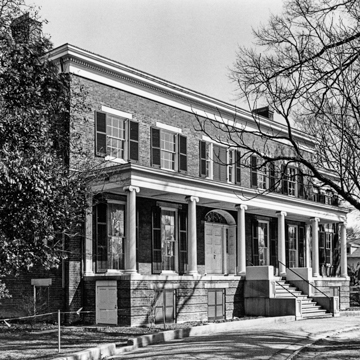You are here
Centre Hill Museum (Centre Hill)
Centre Hill was built for Robert Bolling Jr., who, following his father, was the largest landowner in Petersburg. Belied by the fairly austere brick exterior, his two-story, double-pile house was the most lavish dwelling in the prosperous town. Its center passage, reached from the elaborate fan- and sidelit door, was flanked by double parlors on one side and a dining room and possibly a chamber on the other. With rich finishings in late Federal woodwork, marble mantels, and decorative plasterwork, the Bolling house paid tribute to the family's entrepreneurial success. In 1840–1841, the house was greatly enhanced by Bolling's son, Robert Buckner Bolling, who gave it a Greek Revival overlay. He further embellished it ten years later with fluted Corinthian columns supporting an entablature over the double-parlor door and decorative plasterwork, lowered the first-floor windowsills, and replaced the front and rear porches. By raising the roof several brick courses, chambers were created in the new attic, probably for the use of servants. A wing was also built on the east end that expanded service space, created an office, and included bedrooms.
After the Siege of Petersburg in 1864–1865, the house served as headquarters of Union general G. L. Hartsuff, who was visited here by President Abraham Lincoln on April 7, 1865. In the early twentieth century, a grand stairway was added. Between 1914 and 1923, the lawn in front of the house was developed with a small court of bungalows and Craftsman-influenced foursquare houses arranged around a crescent. The house is now a city-run museum.
Writing Credits
If SAH Archipedia has been useful to you, please consider supporting it.
SAH Archipedia tells the story of the United States through its buildings, landscapes, and cities. This freely available resource empowers the public with authoritative knowledge that deepens their understanding and appreciation of the built environment. But the Society of Architectural Historians, which created SAH Archipedia with University of Virginia Press, needs your support to maintain the high-caliber research, writing, photography, cartography, editing, design, and programming that make SAH Archipedia a trusted online resource available to all who value the history of place, heritage tourism, and learning.














